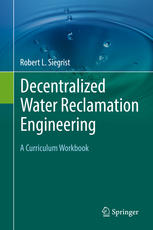

Most ebook files are in PDF format, so you can easily read them using various software such as Foxit Reader or directly on the Google Chrome browser.
Some ebook files are released by publishers in other formats such as .awz, .mobi, .epub, .fb2, etc. You may need to install specific software to read these formats on mobile/PC, such as Calibre.
Please read the tutorial at this link. https://ebooknice.com/page/post?id=faq
We offer FREE conversion to the popular formats you request; however, this may take some time. Therefore, right after payment, please email us, and we will try to provide the service as quickly as possible.
For some exceptional file formats or broken links (if any), please refrain from opening any disputes. Instead, email us first, and we will try to assist within a maximum of 6 hours.
EbookNice Team

Status:
Available5.0
33 reviewsThis book presents technical information and materials concerning the engineering of decentralized infrastructure to achieve effective wastewater treatment while also minimizing resource consumption and providing a source of reclaimed water, nutrients and organic matter. The approaches, technologies and systems described are targeted for green building and sustainable infrastructure across the United States and similar industrialized nations, but they are also applicable to water and sanitation projects in developing regions around the world. Today, decentralized infrastructure can be used to sustainably serve houses, buildings and developments with water use and wastewater flows of 100 to 100,000 gal/d or more.
The book provides in-depth engineering coverage of the subject in a narrative and slide format specifically designed for classroom lectures or facilitated self-study. Key topics are covered including: engineering to satisfy project goals and requirements including sustainability, contemporary water use and wastewater generation and methods to achieve water use efficiency and source separation, alternative methods of wastewater collection and conveyance, and treatment and reuse operations including tank-based (e.g., septic tanks, aerobic treatment units, porous media biofilters, membrane bioreactors), wetland-based (e.g., free water surface and vegetated subsurface bed wetlands), and land-based unit operations (e.g., subsurface soil infiltration, shallow drip dispersal). Approaches and technologies are also presented that can achieve nutrient reduction and resource recovery in some cases or pathogen destruction to enable a particular discharge or reuse plan. The book also describes requirements and methods for effective management of the process solids, sludges and residuals that can be generated by various approaches, technologies, and systems. The book contains over 300 figures and illustrations of technologies and systems and over 150 tables of design and performance data. There are also more than 200 questions and problems relevant to the topics covered including example problems that have solutions presented to illustrate engineering concepts and calculations.